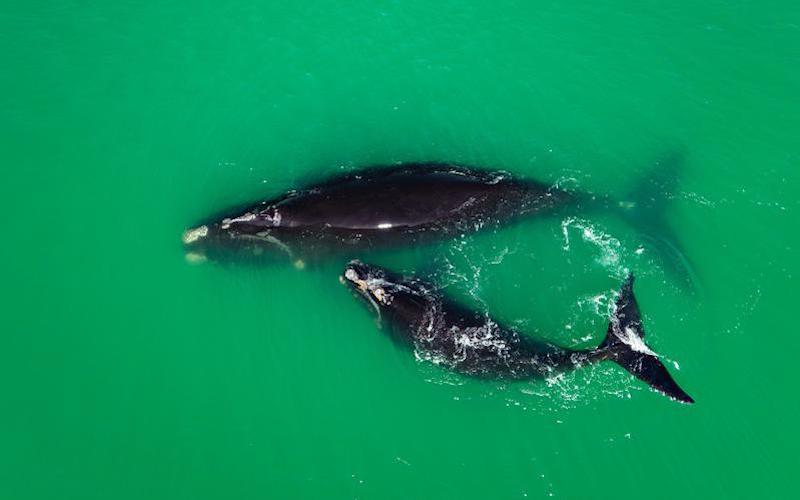
A right whale adult and calf. Photo: Brian Skerry/NOAA permit #21371
January 10, 2024 (BOSTON, MA) – A two-month-old right whale calf whose head, mouth, and lips were split open by a boat’s propeller was spotted off the coast of South Carolina on January 6. Fishermen who sighted the calf recognized that the whale was injured and provided the video and images they obtained to NOAA Fisheries.
According to today’s announcement from NOAA, the calf is not expected to survive and is one of only nine calves born to the species so far this year. Wound analyses of the images are underway to estimate the size of the vessel that struck the calf. Preliminary results indicate it was not a large ship.
“There are so few right whales left that every death brings this species closer to extinction,” said CLF Senior Attorney Erica Fuller. “This calf isn’t even two months old and yet it’s not expected to live because the federal government has delayed meaningful action for more than a decade. NOAA must publish its final rule immediately and protect this majestic species before it disappears from our oceans forever.”
North Atlantic right whales are a critically endangered species with fewer than 360 remaining. Vessel strikes are one of two primary threats to the species’ existence, along with accidental entanglements in commercial fishing gear. Right whales begin giving birth to calves around mid-November and the season lasts until mid-April. Both females and calves in southeastern waters are especially vulnerable during that time.
In November 2022 and again in October 2023, conservation groups filed for emergency petitions to protect vulnerable mothers and calves in their southeast calving habitat. NOAA Fisheries denied both petitions citing their proposed updated speed rule that, albeit strengthened, has been delayed for at least two years with no release date in place.
This calf was the first sighted during the calving season when researchers documented “Juno” (right whale #1612) off South Carolina with this, her 8th known calf. According to researchers at the New England Aquarium, Juno’s life has been marred by tragedy with her family having sustained at least 24 entanglement events and two previous vessel strikes.
“The real tragedy here is that this was preventable,” said Regina Asmutis-Silvia, executive director of Whale and Dolphin Conservation. “Juno is doing her job by having babies but politics are killing them faster than she can reproduce. It’s inexcusable.”
With a declining population and only 70 breeding females, the North Atlantic right whale will almost certainly go extinct without key conservation measures. Current regulations are not sufficient to protect the whales, and changes proposed by NOAA Fisheries are unlikely to go into effect before the end of this year’s calving season.
“Right whale calves are a crucial sign of hope and recovery for the species, and it’s absolutely heartbreaking that one has been hit by a vessel,” said Kristen Monsell, oceans legal director at the Center for Biological Diversity. “What makes this tragedy even worse is that the whale calf could have been saved by a speed limit rule like the one we’ve been pushing for. The federal government keeps dragging its feet at the expense of these critically endangered whales.”
Experts are available for further comment.
###
